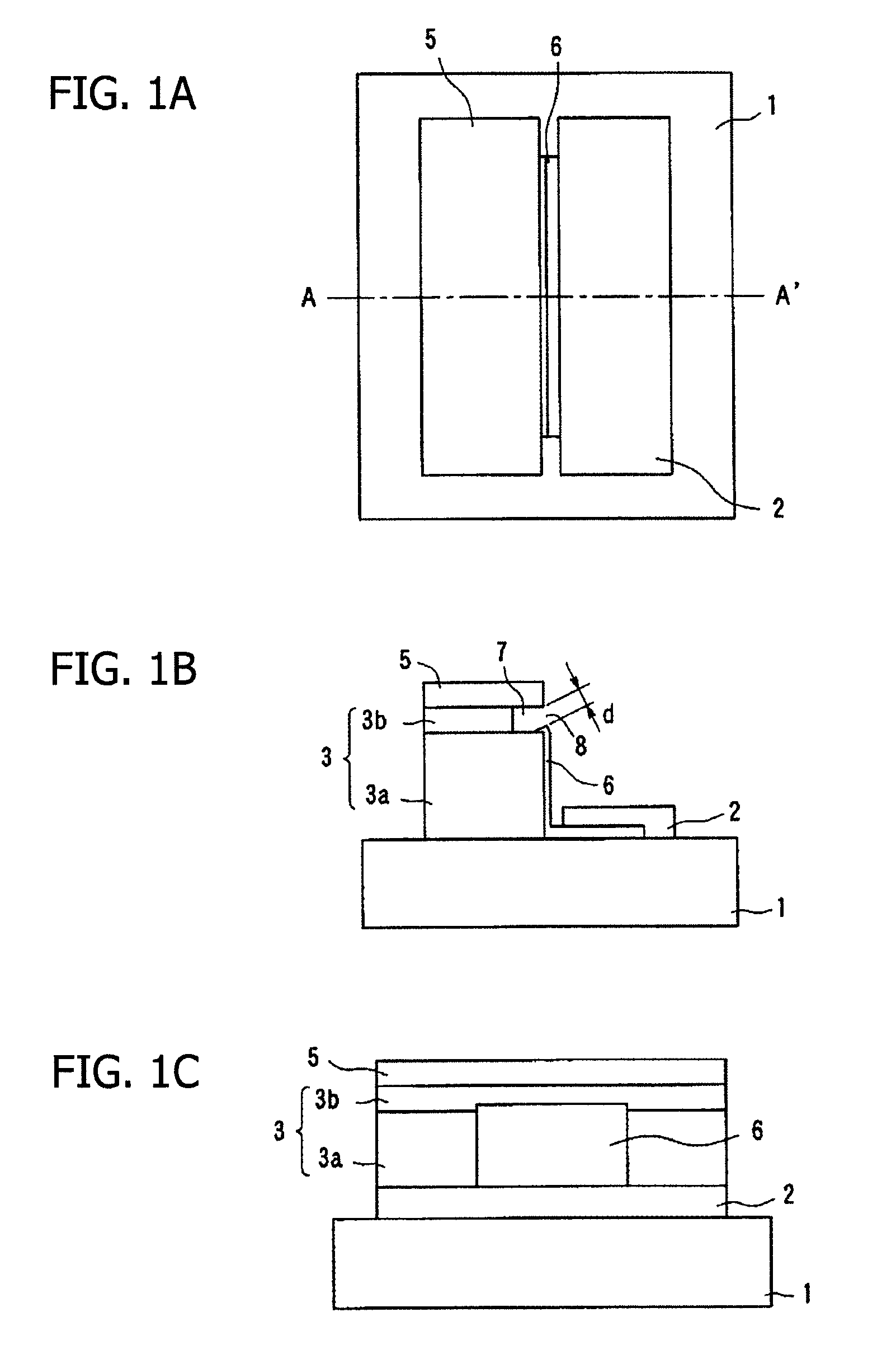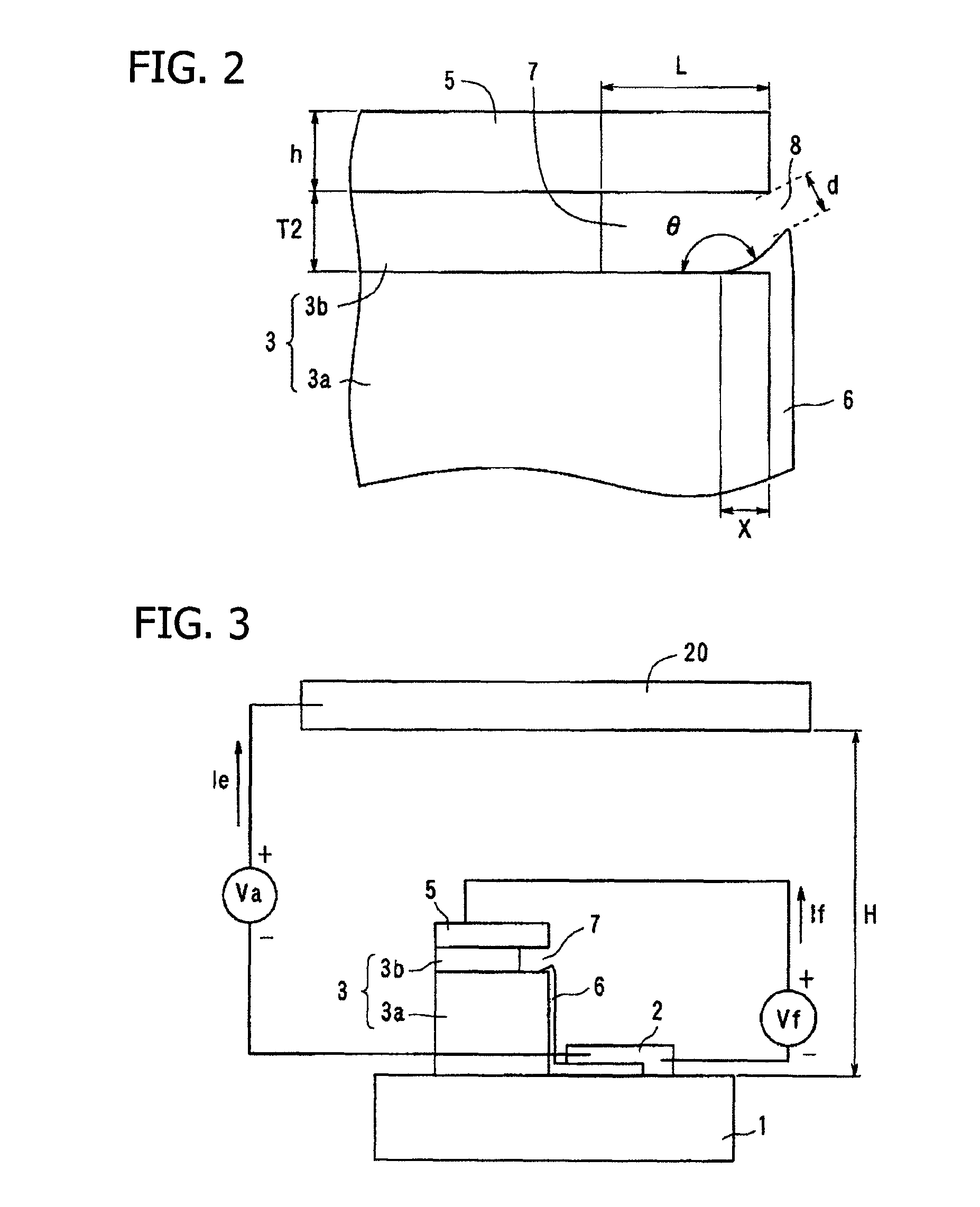Electron beam apparatus and image display apparatus using the same
a technology of image display and electron beam, which is applied in the manufacture of electrode systems, electric discharge tubes/lamps, and discharge tubes luminescnet screens, etc., to achieve stable electron emission characteristics, inhibit gate deformation, and stable image display
- Summary
- Abstract
- Description
- Claims
- Application Information
AI Technical Summary
Benefits of technology
Problems solved by technology
Method used
Image
Examples
example
First Example
[0146]The electron-emitting device having the configuration illustrated in FIG. 1 was manufactured according to the process in FIGS. 12A to 12G. FIG. 13 is a perspective view thereof.
[0147]First, as illustrated in FIG. 12A, PD200 made of low-sodium glass was used as the substrate 1, a 500 nm-thick SiN (SixNy) film was formed by the sputtering as the insulating layer 22, then a 23 nm-thick SiO2 film was formed by the sputtering as the insulating layer 23. Further, a 30 nm-thick TaN film was formed by the sputtering as the conductive layer 24 on the insulting layer 23.
[0148]Next, after forming the resist pattern on the conductive layer 24 by the photolithography technique, the conductive layer 24 and the insulating layers 23 and 22 were sequentially processed by using the dry etching method, and the insulating member 3 composed of the insulating layers 3a and 3b and the gate 5 were formed as illustrated in FIG. 12B. Since the material to form fluoride was selected in the ...
second example
[0157]Next, the electron-emitting device was manufactured in which etching depth of the insulating layer 3b (depth of the concave portion 7) was made shallower than that of the first example, and an effect thereof was studied. Although the made device was similar to that of the first example, the etching depth when forming the concave portion 7 by etching the insulating layer 3b was set to 120 nm. As a result of the analysis by the cross-sectional TEM and the frontal SEM, the distance d of the gap 8 between the protrusion of the cathode 6 being the emitting unit and the gate 5 in FIG. 2 was 3 nm at the minimum and the average value thereof was 14.8 nm. When performing the property evaluation similar to that in the first example using the electron-emitting device thus obtained, as illustrated in FIG. 15, the sudden large current was generated when Vf=30 V.
[0158]In table 1, the configuration of the element, presence or absence of the large current generation, and a value of the upper ...
third example
[0162]The electron-emitting device was manufactured in which the gate 5 was thicker than that in the first example, and the effect thereof was studied. Although the made device was similar to that of the first example, the thickness T2 of the gate 5 was set to 36 nm. As a result of the analysis by the cross-sectional TEM and the frontal SEM, the distance d of the gap 8 between the protrusion of the cathode 6 being the emitting unit and the gate 5 in FIG. 2 was 3 nm at the minimum and the average value thereof was 14.5 nm. When the property evaluation similar to that of the first example was performed by using the electron-emitting device thus obtained, as illustrated in FIG. 16, stable device current was obtained without occurrence of the sudden large current as in the first example in a range in which the voltage up to Vf=26 V was applied.
[0163]In the third example, the upper limit of L / h by the equation (18) when Vf=24 V is represented as
L / h≦4.5 (24-2).
Since L / h=4.29 with L=150 n...
PUM
 Login to View More
Login to View More Abstract
Description
Claims
Application Information
 Login to View More
Login to View More - R&D
- Intellectual Property
- Life Sciences
- Materials
- Tech Scout
- Unparalleled Data Quality
- Higher Quality Content
- 60% Fewer Hallucinations
Browse by: Latest US Patents, China's latest patents, Technical Efficacy Thesaurus, Application Domain, Technology Topic, Popular Technical Reports.
© 2025 PatSnap. All rights reserved.Legal|Privacy policy|Modern Slavery Act Transparency Statement|Sitemap|About US| Contact US: help@patsnap.com



